|
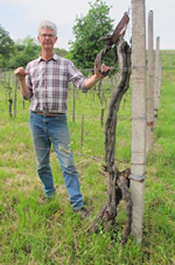 Slovenia is divided into three wine zones further sub-divided into 9 sub zones. The western zone adjoining Italy is Primorska (The Coast) divided into Koper, Kras, Vipava Valley and Goriška Brda. I visited 6 wineries in the last 2 sub-zones during my recent trip to Slovenia. Here is a report: Slovenia is divided into three wine zones further sub-divided into 9 sub zones. The western zone adjoining Italy is Primorska (The Coast) divided into Koper, Kras, Vipava Valley and Goriška Brda. I visited 6 wineries in the last 2 sub-zones during my recent trip to Slovenia. Here is a report:
VALTER MLEČNIK WINE CELLAR
www.mlecnik.eu
v.mlecnik@gmail.com
Contact Person: Valter Mlečnik
Based in a small village called Bukovica in Vipava Valley in Goriška region, Valter Mlečnik has been famous for making organic/bio-dynamic wines for 15 years-though the winery was certified organic in 2005. He took over the family winery located in a 17th century building, in 1983. His vision goes beyond the vineyard into the winery. The lanky Valter is in the forefront of natural wine production in modern Slovenia and one of the few making only natural wines.
It’s not important only to be organic or biodynamic in the vineyard with disastrous intervention in the winery, he stresses. To maintain nature in the bottle, natural harmony is important till the bottling. ‘We know nature and must respect it while making wine,’ he tells me. ‘Producing natural wines is like raising children-controlling them a little to build their character but making them stand on their own feet,’ he says. He uses no yeast, irrigation or chemicals and does not control temperature of fermentation and adds little sulphites. The fermentation is in stainless steel tanks or big, neutral oak barrels, with no filtration. White Grapes are macerated for 3-5 days and reds for 2 weeks. He keeps the bottles for a minimum of 2-3 years before releasing them.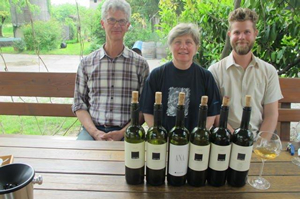
He owns 9.5 hA land with many old vines-some older than 60 years old, with low yields of 0.5 kgm per plant; I remember fondling one that was planted by his grandfather in 1947 (year of Independence for India). He produces only 12,000 bottles of natural wine though he is trying to optimize his vineyards to take the number to 20,000. In 2008, the number went down to 4000 bottles because of one week of rain during the flowering and a lot of mildew. He has planted Chardonnay, Rebula (Ribolla Gialla), Sauvignonasse (former Tokai Friulano), Istrian Malvasia, a local variety Pinela and Merlot.
There is no official definition of natural wines globally but Valter likens it to multi-grain bread as compared with regular wines which are like white bread. In fact, he feels only natural wines should be called wines, there should be another name evolved for the modern wines that are made using pesticides and chemical fertilizers and artificial control of temperature.
Although not all orange wines are natural, he is not averse to the growing popularity of the name for this category and feels the terminology has at least brought focus on natural wines. He is aware that in Australia there is an Orange Appellation, upset about the name being bandied around for these wines. (I may clarify for Indian readers that orange wines have nothing to do with oranges!). He is clear that the modern day winemaking with chemicals and fertilizers and too much of intervention has changed the old style used for centuries.
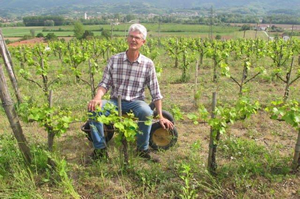 For him Italy is the most lucrative market. Japan is very important with a small amount sold in Austria, Slovenia, Spain and Poland. For him Italy is the most lucrative market. Japan is very important with a small amount sold in Austria, Slovenia, Spain and Poland.
Mlečnik wines are not for everyone’s pocket or palate. Costing € 13.5 for Ana to €25 for Chardonnay, they are for people who seek wines for the soul. I have coined the term ‘intellectual wines’ for these wines. They need an evolved palate but his ‘pure’ wines do not need much time to align with the palate. We were scheduled to meet for an hour, but there was enough chemistry between the two of us to spend over 3 hours while his wife kept streaming home-made salads and several local dishes. Beyond the tasting, I found myself asking for refills of the natural Chardonnay as we conversed about the world of natural wines- a fantastic learning experience.
Mlečnik is a member of the ViniVeri Association (www.viniveri.net) which has members committed to natural wines. It started participating in Vinitaly around the turn of the millennium but branched off into organising a parallel wine show near Verona at the same time as Vinitaly where he participates regularly.
TILIA ESTATE
www.tiliapremiumwines.com
info@tiliapremiumwines.com
Contact Person: Matjaz Lemut tilia@lemut.net
Set up in Dobravlje in Vipavska Dolina (Vipava Valley), close to Mlečnik, the winery is owned and run by Matjaz Lemut who studied economics in Switzerland and his wife Melita who has done a PhD, specialising in Pinot Noir. Her dissertation topic was ‘Canopy microclimate manipulation in the sustainable management of Pinot Noir vineyard in the Vipava valley’. Therefore, it is not surprising that they specialise in Pinot Noir. Recently, the oenologist couple even declared theirs as House of Pinot. Starting in 1996, they are celebrating the 20th year of their harvest as Tilia – a label that signifies the Latin name for the Linden tree growing on the estate.
 The boutique winery produces 50,000 bottles (about 4000 cases) a year and exports to UK (Naked Wines), USA, Belgium, France and Bulgaria. Although Pinot Noir is getting more and more attention, they are also making Pinot Gris, Sauvignon Blanc, Chardonnay as well as the most popular grape of Vipava Valley, Rebula, which forms about a third of the production. The grey Pinot is more on the style of Gris, with full concentration of flavours. Though 2014 was a poor vintage, the winery has done a very good job with the Grigio. Even the Sauvignon Blanc 2014 was intensely perfumed, fruity and crisp with good length and leaving a pleasant after-taste (89). Chardonnay 2014 was not my favourite wine though (85). The boutique winery produces 50,000 bottles (about 4000 cases) a year and exports to UK (Naked Wines), USA, Belgium, France and Bulgaria. Although Pinot Noir is getting more and more attention, they are also making Pinot Gris, Sauvignon Blanc, Chardonnay as well as the most popular grape of Vipava Valley, Rebula, which forms about a third of the production. The grey Pinot is more on the style of Gris, with full concentration of flavours. Though 2014 was a poor vintage, the winery has done a very good job with the Grigio. Even the Sauvignon Blanc 2014 was intensely perfumed, fruity and crisp with good length and leaving a pleasant after-taste (89). Chardonnay 2014 was not my favourite wine though (85).
The Pinot Noirs were a real pleasure, starting with the 2013 made from young 4- year old vines. Full of rose petal aromas, it was still young and astringent but had good aging potential (88). Another label of 2013 made from 15 year old vines was much more delicious, fuller and with more complex flavours and intense aromas (89).
The top wine is White Label Pinot Noir, made from the best grapes and using barrels with a single pass, procured from Louis Latour in Burgundy. The 2013 had been bottled only a couple of months earlier and still needed a few years of bottle aging but with 7 gms/liter acidity it had a fresh flavour with softer but fuller tannins and a lot of astringency and higher alcohol at 15.5% (92). The 2012 shows their potential as Pinot Noir specialists. It was full on the palate, still young but very elegant and balanced with good aging potential (93). Of course it comes at a price (€40)!
The Estate (I don’t know how they call themselves one, as they buy some of their grapes-especially for Pinot Grigio. Apparently there are no laws that define an estate in Slovenia. The winery is a good source for Pinot Noir lovers looking for different Terroir and personality.
VALTER SIRK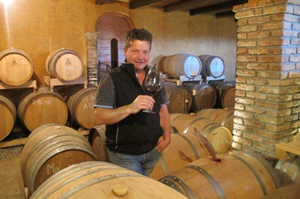
http://www.valtersirk.com
valter.sirk@siol.net
Contact Person: Valter Sirk
The winery in Visnjevik in Dobrovo in the picturesque area of Goriška Brda near the Italian border was under renovation when I went to visit but Valter Sirk was kind enough to take me through his cellar and taste several wines with me.
The Sirk family has worked in vines and wines for generations. But it was in 1991 that they started their own wine production with Valter Sirk vineyard and cellar. Known for high quality and fresh wines, they have the usual autochthon varieties like Rebula (Ribolla Gialla), Sauvignonasse, Malvasia and also the international varieties like Pinot Grigio (Sivi Pinot), Chardonnay, Sauvignon Blanc, Cabernet Sauvignon and Pinot Noir.
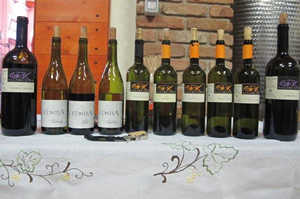 The wines are generally fermented in stainless steel tank with 20 % in oak barrels to increase creaminess in the wine. Besides varietals, there are also two blended wines aged in barriques (old and new)- Teresa White (blend of Chardonnay, Pinot Bianco, Sauvignonasse and Malvasia) and Red ( Merlot, Cabernet Franc and Malbec) which are excellently made wines. The wines are generally fermented in stainless steel tank with 20 % in oak barrels to increase creaminess in the wine. Besides varietals, there are also two blended wines aged in barriques (old and new)- Teresa White (blend of Chardonnay, Pinot Bianco, Sauvignonasse and Malvasia) and Red ( Merlot, Cabernet Franc and Malbec) which are excellently made wines.
After a period of growth in the domestic market, the company also exports to Italy with the help of the Trieste-based Italian partner and the rest of Europe- and even beyond.
EDI SIMČIČ
http://www.edisimcic.si/index_en.html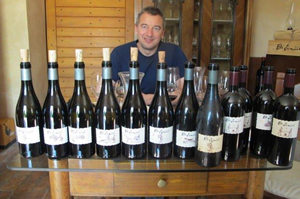
info@edisimcic.si
Contact Person: Aleks Simčič
Located in a predominantly residential area in the small village of Vipolže, Dobrovo in Goriška Brda –Goricia Collio (Slovenian equivalent of the adjoining Colli Orientali in Italy), the winery is difficult to locate unless you are with someone, but it’s worth a visit if you are looking for a boutique winery producing high quality wines.
After World War II, when Yugoslavia annexed this territory previously held by Italy, Edi Simčič found his vineyards 500 meters on the wrong side of the border. Instead of selling freely, he was forced to supply grapes to the government-controlled cooperative. After Slovenia became free in 1991, the Simčič family set up a winery and in a short span of time became a leading quality boutique producer, so well-known overseas that it exports 70% of the annual production of around 3,000 cases.
Edi’s son, winemaker Aleks Simčič has renovated the old cellar and looks after the business. I met and tasted a range of Edi Simčič wines with him. They specialise in the white Rebula, the most important grape in the Brda region. ‘The majority grows on the Slovenian side as it needs to be planted on the steep and poor soil. But it also needs heavy selection in the vineyard, with our 40+ year old vine adding to the intensity,’ he says.
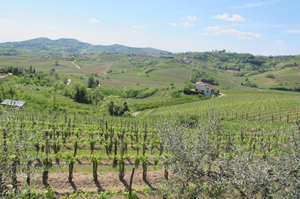 In addition to its 4.5 acres of Rebula, Simčič has 5 acres of Chardonnay, 3.75 acres of Sauvignon Blanc, 2.5 acres of Pinot Gris, and an acre each of Malvasia, Sauvignonasse and Pinot Blanc, as well as 8.75 acres of Merlot and 1.25 acres each of Cabernet Sauvignon and Cabernet Franc. In addition to its 4.5 acres of Rebula, Simčič has 5 acres of Chardonnay, 3.75 acres of Sauvignon Blanc, 2.5 acres of Pinot Gris, and an acre each of Malvasia, Sauvignonasse and Pinot Blanc, as well as 8.75 acres of Merlot and 1.25 acres each of Cabernet Sauvignon and Cabernet Franc.
The wines are expensive, justified by quality. Aleks justifies the prices because of the cost being higher as the vineyards are situated on very hilly areas requiring manual work. The winery thus aims for higher quality rather than cheaper wines. They use sustainable agriculture with practically no use of herbicides or pesticides. Low yields of about 1.5 tons/acre costs more to grow vines but they do not need any additional fertilizing.
The winery also has a small luxurious villa called Alma Vista with a modern Spa and a swimming pool for 4-8 persons. Like other similar projects, it has been constructed with the help of an EU grant of 45% in conjunction with the government. If you want to spend a few days in the lap of luxury and drink high quality wines, this is the place to be-with beautiful vistas of the Brda hills.
MOVIA
www.movia.si
movia@siol.net
Contact Person: Vesna Kristančič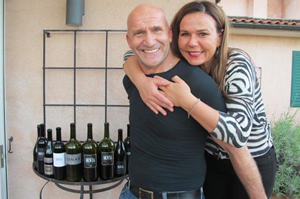
For many wine aficionados inside Slovenia and a majority outside, Ceglo based Movia in Dobrovo is Slovenia and Slovenia is Movia. The 6th generation family owner Ales Kristančič isconsidered a wine genius by some and an eccentric by others. Most think of him as unpredictable. But nobody denies his innovative and unorthodox style of winemaking and his experimenting with new ideas. His histrionics can make you go wild with laughter.
The tasting room in the porch outside the building that looks like a villa, faces one of the most beautiful vineyard landscapes in Slovenia and is a perfect setting for wine tasting. As we enter and exchange greetings with his charming wife Vesna Kristančič she tells us that he is in the winery and will show up soon. Her favourite (and ours) music is playing on a juke box in the adjoining sitting room as she proceeds to uncork a bottle of sparkling wine labelled Puro 2006 with no cage. She has an ice bucket full of water in front. She pops the cork as she dips the inverted bottle instantly into water. The blob of sediments is ejected into water. She quickly straightens the bottle and pours the bubbly into our glasses which have an unusually long stem and a bowl like a compressed Bordeaux wine glass- designed by Movia. The wine has been disgorged right in front of our eyes.
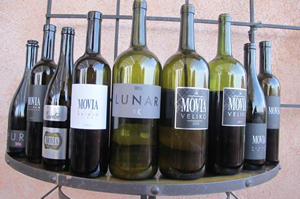 This unique innovation of Ales has resulted in the Puro- a Rebula and Chardonnay blend, with only 5mg of sulphites as compared to 60-80 mg for other sparkling wines, we are told. Since it is disgorged only before drinking, every bottle has a much longer shelf life. As Vesna explains, the bottles are supplied on a thick, cylindrical cardboard holder and during transportation and storage the bottles must be kept inverted. This unique innovation of Ales has resulted in the Puro- a Rebula and Chardonnay blend, with only 5mg of sulphites as compared to 60-80 mg for other sparkling wines, we are told. Since it is disgorged only before drinking, every bottle has a much longer shelf life. As Vesna explains, the bottles are supplied on a thick, cylindrical cardboard holder and during transportation and storage the bottles must be kept inverted.
Movia has been owned by the Kristančič family since 1820. Thanks to Ales Movia is considered one of the best producers of Slovenia. He owns 22 hA vineyards about 8 hA of which are in Italy. Elevating from grape growing to wine making, 90,000 to 130,000 bottles are produced every year. Italy is his best market though he sells all over EU, US, Japan and other countries.
He is an avid fan of Natural wines. Lunar is one such wine-his most recent creation. Made from Rebula, it is orange in colour, aged for 9-12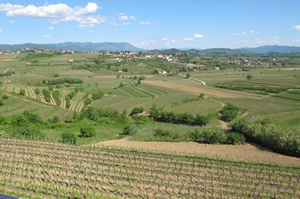 months in barrels buried 25 feet underground without intervention. Like Puro it’s also bottled on lees and has to be decanted to remove the sediments. months in barrels buried 25 feet underground without intervention. Like Puro it’s also bottled on lees and has to be decanted to remove the sediments.
Another interesting wine that has a unique personality is Veliko –the Red is an unusual, deep-flavoured blend of Merlot, Pinot Noir and Cabernet Sauvignon. The whites are made in an unusually oxidative style. Sauvignon Blanc, for instance, is subjected to two years of aging in oak casks- an approach being followed by many top Slovenian producers.
While we taste, Ales joins and chats with us for almost an hour by the end of which we are splitting with laughter. He is enamoured by India-as is his wife Vesna. With his unique style and innovative approach he should have a niche market in India for his wines which are being lapped up by Sommeliers and wine connoisseurs in US, who are bored with regular wines and looking for something unique and different. Movia provides several interesting options in regular, organic, orange or natural wines.
BLAZIC WINES
vina.blazic@siol.net
Contact: Borut Blazic
This is another family run boutique wine estate in Goriška Brda, near the Italian border at Cormons in Friuli Venezia Giulia area. I still can’t get over the fact that I could keep one leg in Slovenia and the other in Italy at his farm. The estate based in Plesivo, Dobrovo is dedicated to white and orange wines with annual sales of around 30,000 bottles, though a small quantity of reds is also in the portfolio. The Blazic family has been in the business of growing and selling grapes since 1890. But it was 100 years later that the current owner Borut Blazic started bottling and selling his wines in 1993.
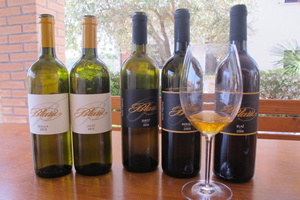 With 7hA of vineyards spread over Slovenia and Italy across the notional border, he specialises in Rebula (Ribolla Gialla) but also makes Pinot Grigio, Sauvignonasse, and Malvasia in the ZGP Brda appellation. He is a well-known producer for quality orange wines (his top quality Sauvignonasse Selection sells for over €25). But selling is not easy for him, he concedes. The demand is growing for orange wines but the number of producers has also been going up, he says. There were 2-3 producers in 2000 but now there are a total of around 30-40 of them in this area! With 7hA of vineyards spread over Slovenia and Italy across the notional border, he specialises in Rebula (Ribolla Gialla) but also makes Pinot Grigio, Sauvignonasse, and Malvasia in the ZGP Brda appellation. He is a well-known producer for quality orange wines (his top quality Sauvignonasse Selection sells for over €25). But selling is not easy for him, he concedes. The demand is growing for orange wines but the number of producers has also been going up, he says. There were 2-3 producers in 2000 but now there are a total of around 30-40 of them in this area!
I tasted 9 wines while having a delicious lunch outside on the porch prepared by his wife Simona who is an excellent Chef. Noteworthy was a 2006 cuvee of orange wine-a blend of Chardonnay (30%), Pinot Bianco (30%), Rebula (30%), and Sauvignonasse (10%) with 14% alcohol. It had strong aromas, spicy flavour and tasted more like a spicy Palo Cortado Sherry. He sells it to restaurants at €16+tax and makes it only in the best years like 1997, 2000, 2003, 2006 and 2009. These orange wines have an excellent longevity.
He follows organic farming but does not claim to make natural wines like Valter Mlečnik.
The unique Zelén of Vipava Valley
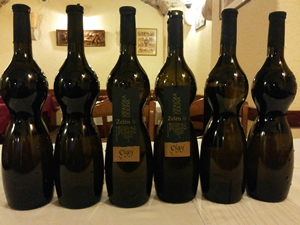 A visit to Vipava Valley cannot be complete without tasting a unique wine we ordered at a restaurant during dinner. Zelén is a unique and rare indigenous white grape variety found in Vipava Valley and nowhere else in the world. It has unique aromas, full of concentrated white stone, fruit flavours and citrus notes. In 2003, 17 producers of this wine came together and formed Association Zelén. With stricter rules than required by law, the wine has to be bottled in a special coke type curvaceous bottle. The bottle, tags, corks and even cardboard packing have to be uniform! Only about 60,000 bottles of this wine which is supposed to have extra oxidants, with aphrodisiac property, are produced. A visit to Vipava Valley cannot be complete without tasting a unique wine we ordered at a restaurant during dinner. Zelén is a unique and rare indigenous white grape variety found in Vipava Valley and nowhere else in the world. It has unique aromas, full of concentrated white stone, fruit flavours and citrus notes. In 2003, 17 producers of this wine came together and formed Association Zelén. With stricter rules than required by law, the wine has to be bottled in a special coke type curvaceous bottle. The bottle, tags, corks and even cardboard packing have to be uniform! Only about 60,000 bottles of this wine which is supposed to have extra oxidants, with aphrodisiac property, are produced.
This pleasant, green and beautiful Brda region is home to excellent wines. Several autochthonous varieties form an excellent match with the delicious dishes. You can taste them in hospitable wine cellars, at wine shops, farms and at characteristic local cultural events. Make an effort to enjoy these Slovenian wines whenever you go to Northeast Italy or Austria, even if you cannot go to Slovenia for an extended holiday. You’d be glad you did!
Subhash Arora
For the earlier Articles and Part 1 of the 2-part series, visit:
Visiting Wineries of Slovenia- Štajerska Slovenija
Blog: I feel sLOVEnia |